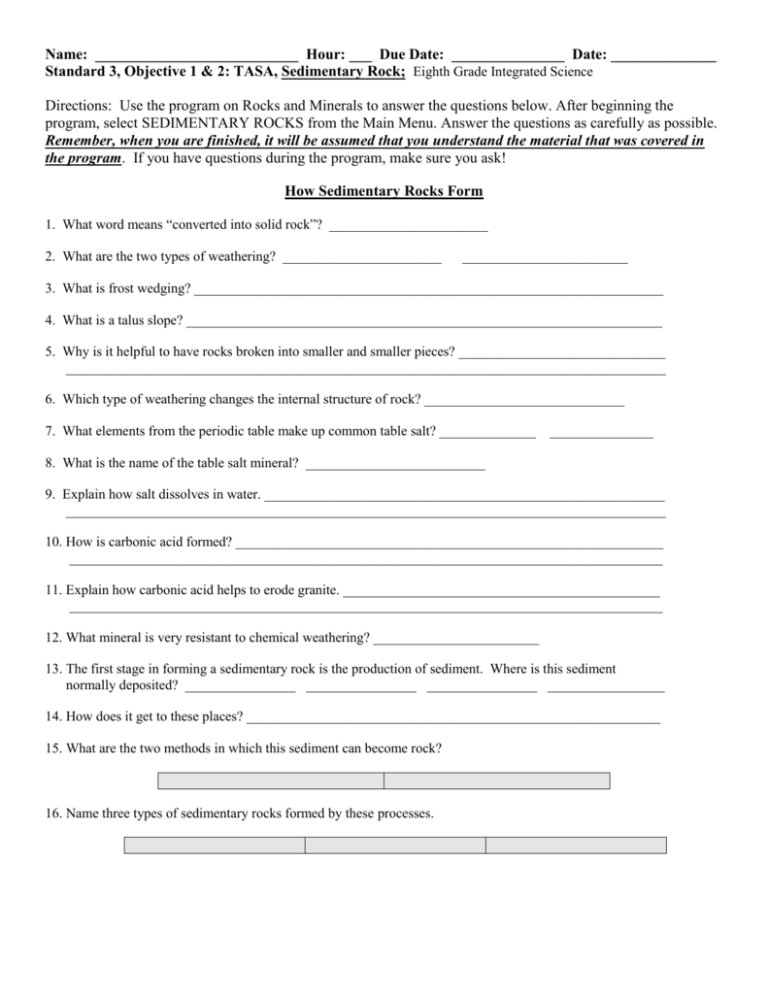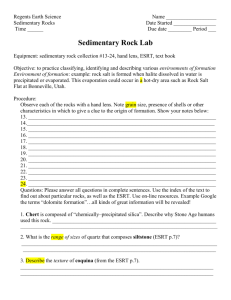TASA, Sedimentary Rock
advertisement

Name: ___________________________ Hour: ___ Due Date: _______________ Date: ______________ Standard 3, Objective 1 & 2: TASA, Sedimentary Rock; Eighth Grade Integrated Science Directions: Use the program on Rocks and Minerals to answer the questions below. After beginning the program, select SEDIMENTARY ROCKS from the Main Menu. Answer the questions as carefully as possible. Remember, when you are finished, it will be assumed that you understand the material that was covered in the program. If you have questions during the program, make sure you ask! How Sedimentary Rocks Form 1. What word means “converted into solid rock”? _______________________ 2. What are the two types of weathering? _______________________ ________________________ 3. What is frost wedging? ____________________________________________________________________ 4. What is a talus slope? _____________________________________________________________________ 5. Why is it helpful to have rocks broken into smaller and smaller pieces? ______________________________ _______________________________________________________________________________________ 6. Which type of weathering changes the internal structure of rock? _____________________________ 7. What elements from the periodic table make up common table salt? ______________ _______________ 8. What is the name of the table salt mineral? __________________________ 9. Explain how salt dissolves in water. __________________________________________________________ _______________________________________________________________________________________ 10. How is carbonic acid formed? ______________________________________________________________ ______________________________________________________________________________________ 11. Explain how carbonic acid helps to erode granite. ______________________________________________ ______________________________________________________________________________________ 12. What mineral is very resistant to chemical weathering? ________________________ 13. The first stage in forming a sedimentary rock is the production of sediment. Where is this sediment normally deposited? ________________ ________________ ________________ _________________ 14. How does it get to these places? ____________________________________________________________ 15. What are the two methods in which this sediment can become rock? 16. Name three types of sedimentary rocks formed by these processes. Conglomerates, Sandstone, and Shale 17. What are the four main minerals used to create sedimentary rocks? 18. How are they divided? ____________________________________________________________________ 19. What is detritus? ________________________________________________________________________ 20. Complete the following table. (This is your starter for today.) Complete the following detrital sedimentary rock chart: Detrital Rock Type Size - Range (millimeters) Particle Name Common Sediment Name Conglomerate Breccia Coquina Sandstone Shale Mud-Stone 21. Soft, crumbly rock (such as shale) forms what type of slopes? _____________________________________ Limestone, Chert, and other Chemical Sedimentary Rocks 22. What is the source of chemical sedimentary rocks? _____________________________________________ 23. What is the most abundant chemical sedimentary rock? __________________________ 24. Name three examples of chemical sedimentary rocks. 25. What are evaporites and name one example. __________________________________________________ Reviewing Sedimentary Rocks 26. Try matching the rocks with there descriptions in the program. Interpreting Past Environments 27. What is the single most characteristic feature of sedimentary rock? ________________________________ 28. What does cross-bedding indicate of past geological conditions? ____________________________________ 29. What do ripple marks indicate of past geological conditions? _____________________________________ 30. What do mud cracks indicate of past geological conditions? ______________________________________ 31. What do fern fossils found in sedimentary rock indicate of past geological conditions? _________________ 32. The stronger the water current, the __________________ the particle size that can be carried.









